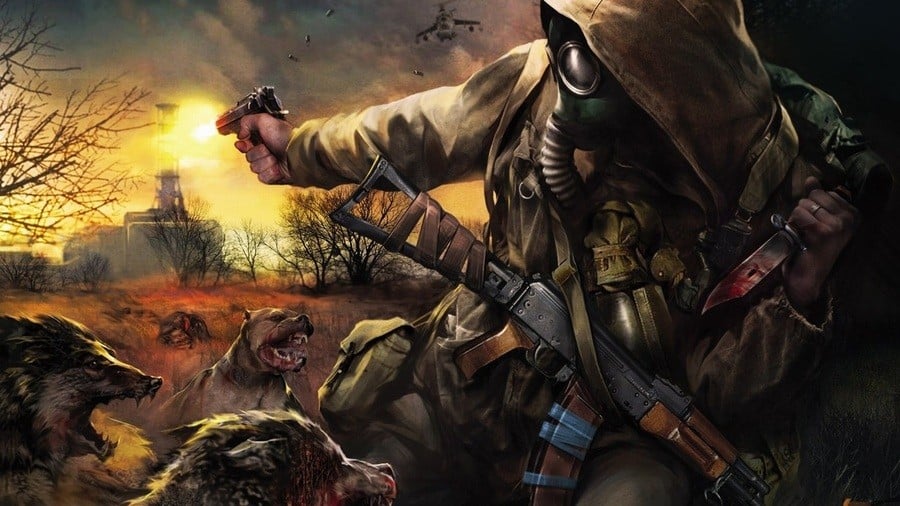
Released in 2007 after a prolonged development period, S.T.A.L.K.E.R.: Shadow Of Chernobyl hardly felt like the kind of game that would eventually sell 2 million copies worldwide.
It was plagued with bugs and other technical issues, and its unforgiving setting hardly screamed mass-market appeal. "I feel like I should warn people off Stalker," wrote Jim Rossignol for Eurogamer. "It's a grim beast, with rough animation and that laggy, about-to-explode feeling you get from some less polished PC games. It's really hard in places, and half the text is gibberish. Worse still, it's going to run like a tired old alcoholic on lower-spec PCs... and yet in spite of all this, I simply cannot stop talking about it."
Commercial success meant that sequels predictably followed, and the most recent of these – S.T.A.L.K.E.R. 2: Heart of Chornobyl – is currently in development, with an expected launch taking place in 2023. Despite being recently overshadowed by the thematically similar Metro series, S.T.A.L.K.E.R. remains popular – and it actually shares a common inspiration with Metro (in fact, the founders of the studio that made Metro 2033 previously worked on S.T.A.L.K.E.R.); both call upon the 1972 Russian novella Roadside Picnic, penned by siblings Arkady and Boris Strugatsky.
Set in the aftermath of an extraterrestrial event called 'the Visitation', Roadside Picnic sees 'stalkers' entering into a forbidden area (known as the Zone) in order to pilfer extraterrestrial items to sell. An immediate hit in its homeland, the book would be adapted into a movie in 1979, directed by Andrei Tarkovsky from a screenplay written by the Strugatsky brothers. A movie which has grown considerably in stature since its release, Stalker is remarkable in that it actually pre-dates the Chernobyl setting seen in the S.T.A.L.K.E.R. video games (the Chernobyl disaster didn't occur until 1986). Despite this fact, the same feelings of unrelenting discomfort can be found within Tarkovsky's film – but the story of its creation is even more unnerving.
Production on Stalker got off to a shaky start. According to production designer Rashit Safiullin, Tarkovsky and Stalker's initial cinematographer, Georgy Rerberg, had a falling out; Igor Mayboroda's documentary Rerberg and Tarkovsky: The Reverse Side of "Stalker" claims that Rerberg told Tarkovsky to rewrite the film's script in order to improve it, and several arguments took place as a result. Safiullin says that Rerberg was ultimately dismissed when it was discovered that, after Tarkovsky had spent a year shooting all the film's outdoor scenes, the film stock hadn't been developed correctly, and the footage was useless (Soviet laboratories were apparently not very familiar with the new Kodak 5247 film stock used). Safiullin claims that Tarkovsky was so depressed at this point the movie was almost abandoned.
However, he pushed on, even convincing the sceptical Soviet film boards to produce the movie in two parts instead of one, thereby securing additional funding and an extended deadline (it was ultimately still released as a single film). A new cinematographer, Alexander Knyazhinsky, was hired. Even then, there were unexpected roadblocks; an earthquake in one of the proposed principal photography locations in Tajikistan forced Tarkovsky to relocate to an abandoned hydroelectric power station in Estonia – a move which would have dramatic consequences.
Upon its release, Stalker was given a frosty response from Soviet critics, some of whom found it slow and plodding. Tarkovsky is claimed to have replied that he was only interested in the views of two people: French filmmaker Robert Bresson (A Man Escaped) and Swedish director Ingmar Bergman (The Seventh Seal). However, the movie sold 4.3 million tickets in the Soviet Union and, in more recent years, has been recognised as a classic piece of cinema; in 2018, Stalker was voted the 49th greatest non-English-language film of all time in a poll by BBC Culture, calling upon the opinions of 209 critics from 43 countries.
Sadly for Tarkovsky and many of the creative forces behind Stalker, there was very little time to bask in its critical success. In 1982, Anatoly Solonitsyn, who played the 'Writer' in the movie, died from terminal lung cancer. Tarkovsky himself succumbed to the same disease on December 29th, 1986, aged just 54. Then, in 1998, Tarkovsky's wife Larisa (who served as assistant director in Stalker) passed away from the same illness.
According to the movie's sound designer Vladimir Sharun, all three of these deaths can be linked to the production of Stalker, which was filmed in a post-industrial wasteland in Estonia. Speaking in 2001, Sharun recalls:
We were shooting near Tallinn in the area around the small river Jägala with a half-functioning hydroelectric station. Up the river was a chemical plant and it poured out poisonous liquids downstream. There is even this shot in Stalker: snow falling in the summer and white foam floating down the river. In fact it was some horrible poison. Many women in our crew got allergic reactions on their faces. Tarkovsky died from cancer of the right bronchial tube. And Tolya Solonitsyn too. That it was all connected to the location shooting for Stalker became clear to me when Larisa Tarkovskaya died from the same illness in Paris.
The movie's focus is an area within the hazard-filled 'Zone', which contains a place called 'The Room' in which a person will find the object of their dreams and desires – but, in the case of one character, it brings unexpected and disastrous consequences. It's ironic, then, that Tarkovsky's quest to create a masterpiece of modern cinema (which Stalker undoubtedly is) could potentially have resulted in him losing his life.
